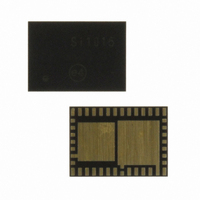SI1013-A-GM Silicon Laboratories Inc, SI1013-A-GM Datasheet - Page 105

SI1013-A-GM
Manufacturer Part Number
SI1013-A-GM
Description
IC TXRX MCU + EZRADIOPRO
Manufacturer
Silicon Laboratories Inc
Specifications of SI1013-A-GM
Package / Case
42-QFN
Frequency
240MHz ~ 960MHz
Data Rate - Maximum
256kbps
Modulation Or Protocol
FSK, GFSK, OOK
Applications
General Purpose
Power - Output
13dBm
Sensitivity
-121dBm
Voltage - Supply
1.8 V ~ 3.6 V
Current - Receiving
18.5mA
Current - Transmitting
30mA
Data Interface
PCB, Surface Mount
Memory Size
8kB Flash, 768B RAM
Antenna Connector
PCB, Surface Mount
Number Of Receivers
1
Number Of Transmitters
1
Wireless Frequency
240 MHz to 960 MHz
Interface Type
UART, SMBus, SPI, PCA
Output Power
13 dBm
Operating Supply Voltage
0.9 V to 3.6 V
Maximum Operating Temperature
+ 85 C
Mounting Style
SMD/SMT
Maximum Supply Current
4 mA
Minimum Operating Temperature
- 40 C
Modulation
FSK, GFSK, OOK
Protocol Supported
C2, SMBus
Core
8051
Program Memory Type
Flash
Program Memory Size
8 KB
Data Ram Size
768 B
Supply Current (max)
4 mA
Lead Free Status / RoHS Status
Lead free / RoHS Compliant
Operating Temperature
-
Lead Free Status / Rohs Status
Lead free / RoHS Compliant
Other names
336-1870-5
- Current page: 105 of 384
- Download datasheet (3Mb)
7.2. Comparator Outputs
When a comparator is enabled, its output is a logic 1 if the voltage at the positive input is higher than the
voltage at the negative input. When disabled, the comparator output is a logic 0. The comparator output is
synchronized with the system clock as shown in Figure 7.2. The synchronous “latched” output (CP0, CP1)
can be polled in software (CPnOUT bit), used as an interrupt source, or routed to a Port pin (configured for
digital I/O) through the Crossbar.
The asynchronous “raw” comparator output (CP0A, CP1A) is used by the low power mode wake-up logic
and reset decision logic. See the Power Options chapter and the Reset Sources chapter for more details
on how the asynchronous comparator outputs are used to make wake-up and reset decisions. The asyn-
chronous comparator output can also be routed directly to a Port pin through the Crossbar, and is available
for use outside the device even if the system clock is stopped.
When using a Comparator as an interrupt source, Comparator interrupts can be generated on rising-edge
and/or falling-edge comparator output transitions. Two independent interrupt flags (CPnRIF and CPnFIF)
allow software to determine which edge caused the Comparator interrupt. The comparator rising-edge and
falling-edge interrupt flags are set by hardware when a corresponding edge is detected regardless of the
interrupt enable state. Once set, these bits remain set until cleared by software.
The rising-edge and falling-edge interrupts can be individually enabled using the CPnRIE and CPnFIE
interrupt enable bits in the CPTnMD register. In order for the CPnRIF and/or CPnFIF interrupt flags to gen-
erate an interrupt request to the CPU, the Comparator must be enabled as an interrupt source and global
interrupts must be enabled. See the Interrupt Handler chapter for additional information.
Analog Input Multiplexer
Px.x
Px.x
Px.x
Px.x
Figure 7.2. Comparator 1 Functional Block Diagram
CP1HYP1
CP1HYP0
CP1HYN1
CP1HYN0
CP1OUT
CP1RIF
CP1EN
CP1FIF
CP1 +
CP1 -
+
-
Rev. 1.0
VDD
GND
Decision
Reset
CPT0MD
Tree
(ASYNCHRONOUS)
(SYNCHRONIZER)
D
SET
CLR
Q
Q
D
SET
CLR
Q
Q
Si1010/1/2/3/4/5
Rising-edge
CP1
Crossbar
Interrupt
Logic
Falling-edge
Interrupt
CP1
CP1A
CP1
CP1
105
Related parts for SI1013-A-GM
Image
Part Number
Description
Manufacturer
Datasheet
Request
R
Part Number:
Description:
QFN 42/I°/8KB, 768B RAM, +13 DBM, PROGRAMMABLE XCVR
Manufacturer:
Silicon Laboratories Inc
Part Number:
Description:
SMD/C°/SINGLE-ENDED OUTPUT SILICON OSCILLATOR
Manufacturer:
Silicon Laboratories Inc
Part Number:
Description:
Manufacturer:
Silicon Laboratories Inc
Datasheet:
Part Number:
Description:
N/A N/A/SI4010 AES KEYFOB DEMO WITH LCD RX
Manufacturer:
Silicon Laboratories Inc
Datasheet:
Part Number:
Description:
N/A N/A/SI4010 SIMPLIFIED KEY FOB DEMO WITH LED RX
Manufacturer:
Silicon Laboratories Inc
Datasheet:
Part Number:
Description:
N/A/-40 TO 85 OC/EZLINK MODULE; F930/4432 HIGH BAND (REV E/B1)
Manufacturer:
Silicon Laboratories Inc
Part Number:
Description:
EZLink Module; F930/4432 Low Band (rev e/B1)
Manufacturer:
Silicon Laboratories Inc
Part Number:
Description:
I°/4460 10 DBM RADIO TEST CARD 434 MHZ
Manufacturer:
Silicon Laboratories Inc
Part Number:
Description:
I°/4461 14 DBM RADIO TEST CARD 868 MHZ
Manufacturer:
Silicon Laboratories Inc
Part Number:
Description:
I°/4463 20 DBM RFSWITCH RADIO TEST CARD 460 MHZ
Manufacturer:
Silicon Laboratories Inc
Part Number:
Description:
I°/4463 20 DBM RADIO TEST CARD 868 MHZ
Manufacturer:
Silicon Laboratories Inc
Part Number:
Description:
I°/4463 27 DBM RADIO TEST CARD 868 MHZ
Manufacturer:
Silicon Laboratories Inc
Part Number:
Description:
I°/4463 SKYWORKS 30 DBM RADIO TEST CARD 915 MHZ
Manufacturer:
Silicon Laboratories Inc
Part Number:
Description:
N/A N/A/-40 TO 85 OC/4463 RFMD 30 DBM RADIO TEST CARD 915 MHZ
Manufacturer:
Silicon Laboratories Inc










